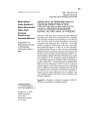

Social Science & Medicine, Elsevier, vol. " Visual representation of statistical information improves diagnostic inferences in doctors and their patients," Garcia-Retamero, Rocio & Hoffrage, Ulrich, 2013.Judgment and Decision Making, Society for Judgment and Decision Making, vol. " Right-wing ideology and numeracy: A perception of greater ability, but poorer performance," Choma & David Sumantry & Yaniv Hanoch, 2019. " Assessing the Effects of Information About Global Population Growth on Risk Perceptions and Support for Mitigation and Prevention Strategies," These are the items that most often cite the same works as this one and are cited by the same works as this one. 21(1), pages 199-206, February.įull references (including those not matched with items on IDEAS) " Better Negative than Positive? Evidence of a Bias for Negative Information about Possible Health Dangers," Michael Siegrist & George Cvetkovich, 2001." The Role of the Affect and Availability Heuristics in Risk Communication," Carmen Keller & Michael Siegrist & Heinz Gutscher, 2006.PLOS ONE, Public Library of Science, vol. Vanya Van Belle & Ben Van Calster, 2015." Validation of the Subjective Numeracy Scale: Effects of Low Numeracy on Comprehension of Risk Communications and Utility Elicitations," " Does Medical Risk Perception and Risk Taking Change with Age?," " The Use of Narrative Evidence and Explicit Likelihood by Decisionmakers Varying in Numeracy," " General Performance on a Numeracy Scale among Highly Educated Samples," " At Home on the Range? Lay Interpretations of Numerical Uncertainty Ranges," Dieckmann & Ellen Peters & Robin Gregory, 2015. " Does Iconicity in Pictographs Matter? The Influence of Iconicity and Numeracy on Information Processing, Decision Making, and Liking in an Eye‐Tracking Study," Christina Kreuzmair & Michael Siegrist & Carmen Keller, 2017." Genetic testing and risk interpretation: How do women understand lifetime risk results?," Yaniv Hanoch & Talya Miron-Shatz & Mary Himmelstein, 2010." Subjective but not objective numeracy influences willingness to pay for BRCA1/2 genetic testing," Talya Miron-Shatz & Yaniv Hanoch & Glen M.From an applied perspective, these results suggest that clinicians may need to ensure that patients do not underestimate risks of medical interventions, and that they convey realistic expectations about the benefits that can be obtained with certain procedures. Moreover, participants’ underestimation of the risks was significantly greater than their overestimation of the benefits.

Objective and subjective numeracy were not associated with more accurate ratings. Participants exhibited optimistic views about the likelihood of experiencing the benefits and the side effects of treatment options described in the scenarios. Participants indicated how likely they were to experience benefits and risks associated with medical conditions and completed objective and subjective numeracy scales. This online study with N = 373 adults aged 19–76 years focused on unrealistic optimism in the health domain. When asked to make separate risk judgments, they give lower risk ratings for themselves than they give for others.3 This " relative bias " in risk estimates appears even when subjects rate only a single target-self or other-and the ratings given the two targets are compared (Harris & Middleton, 1994).People's perceptions of benefits and risks play a key role in their acceptance or rejection of medical interventions, yet these perceptions may be poorly calibrated. When asked to compare themselves to peers, they judge their own risk to be below average. At least in relative terms, people are unrealistically optimistic about their chances of avoiding many negative life events. Implications for interventions designed to influence risk perceptions are discussed. Subjects' estimates decreased with decreases in the comparison statistics, as if subjects attempted to preserve their " below-average " status, but they changed less than did the statistics and were actually pessimistic in comparison to the 50% values. In Study 2, subjects rated their risk after being presented with risk statistics that were 150%, loo%, or 50% of the true values. Study 1 suggested that optimistic biases (the tendency for people to think they are less at risk than the average person) arise more because people overestimating the average person's risk than because they underestimate their own risk. Two studies examined the accuracy of personal risk estimates, as determined by comparing mean estimates made by college students with population statistics for college-educated individuals.


 0 kommentar(er)
0 kommentar(er)
